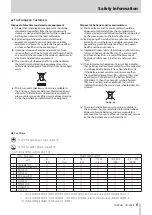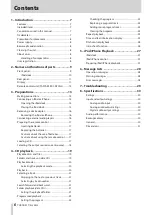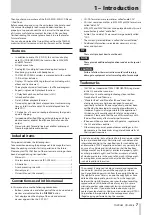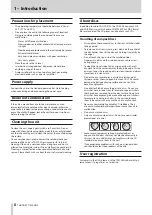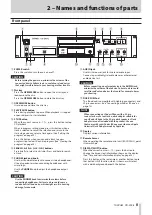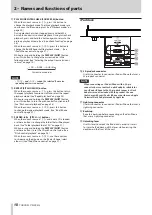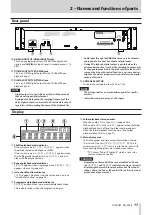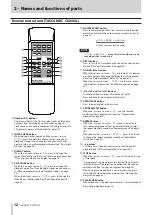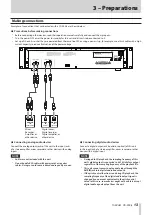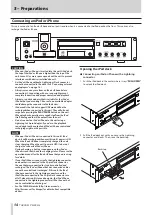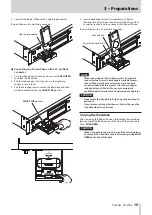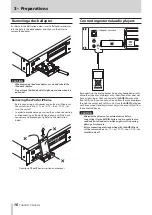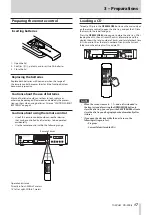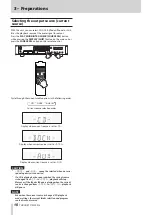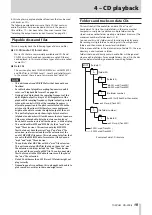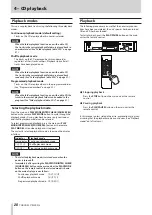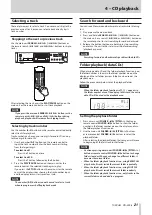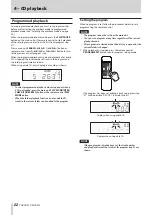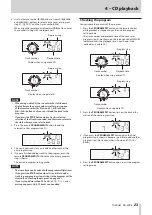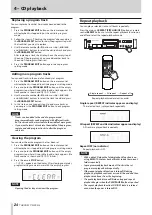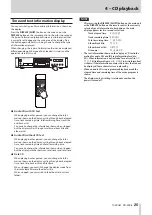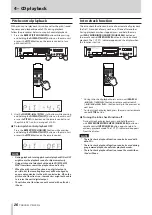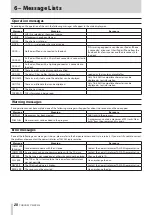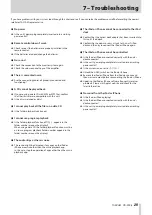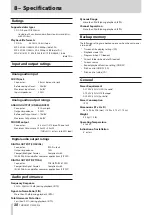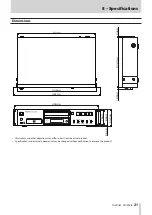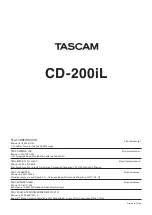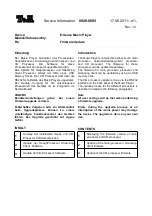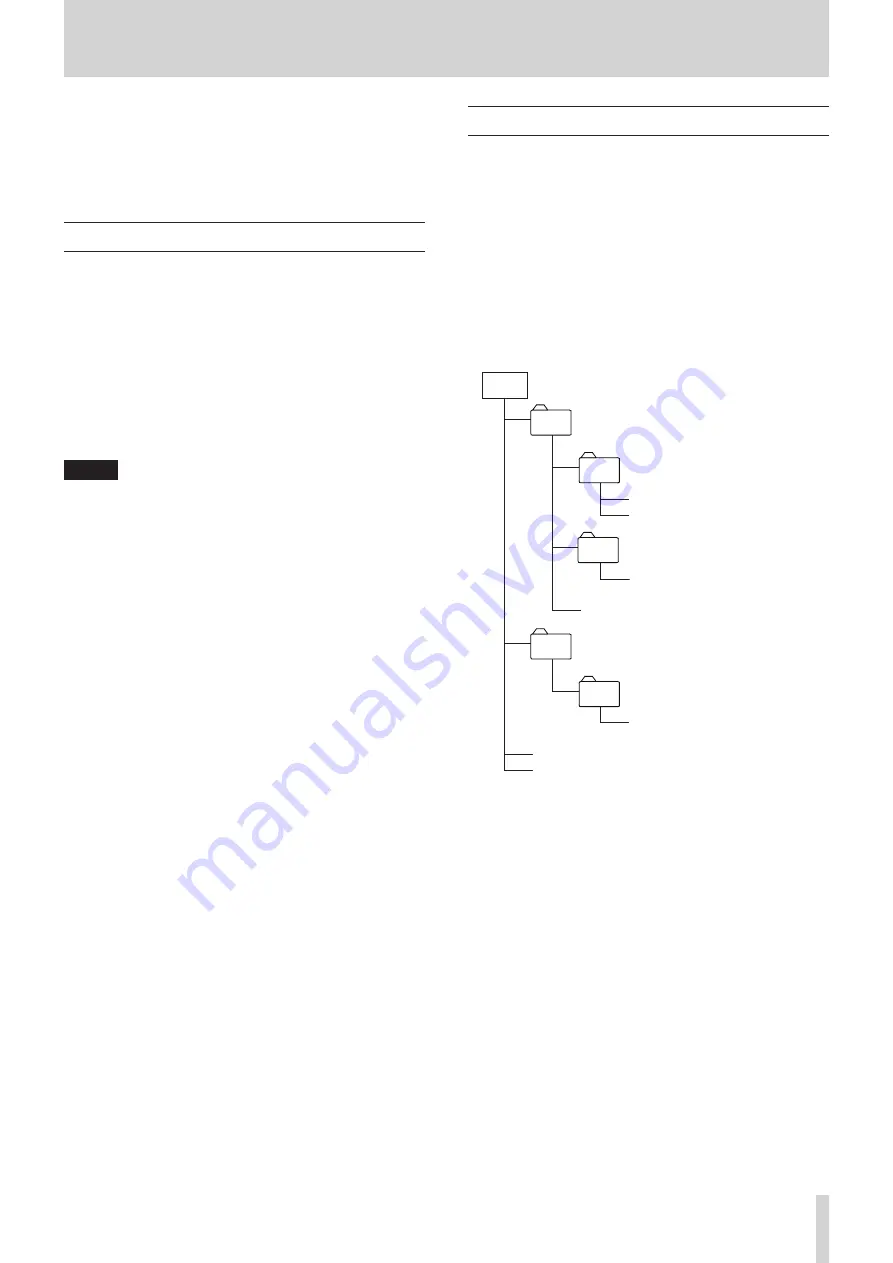
TASCAM CD-200iL
19
4 – CD playback
In this chapter, we explain playback functions that can be used
with tracks on CDs.
The following explanations assume that a CD that contains
audio files/tracks has been loaded in this unit, the power is
ON and the
-CD-
has been set as the current source. (See
“Selecting the output source (current source)” on page 18.)
Playable discs and files
This unit can play back the following types of discs and files.
8
CD-DA (audio CD) format discs
Music CDs that are commercially available and CD-R and
CD-RW discs that have been recorded as audio CD format
can be played. In this manual, these types of discs are called
“audio CDs.”
8
Data CDs
This unit can play back CD-ROM/R/RW discs with MP3, MP2
and WAV files in ISO 9660 Level 1, Level 2 and Joliet formats.
In this manual, these types of discs are called, “data CDs.”
NOTE
•
This unit cannot read CD-R/RW discs that have not been
finalized.
•
For details about playable sampling frequencies and bit
rates, see “Playback file formats” on page 30.
•
During data CD playback, the sampling frequency of this
unit’s digital output is always 44.1 kHz regardless of the
playback file sampling frequency. Digital output is possible
when pitch control is ON, but the sampling frequency is
altered in proportion to the pitch control value. When the
pitch control function is ON, therefore, some equipment
might not be able to receive the digital output of this unit.
•
This unit’s display can only show single-byte characters
(alphabet and numbers). File with names that use Japanese,
Chinese or other double-byte characters can be played
back, but those characters will be shown as
_
on the display.
•
This unit identifies MP3 and MP2 files by their “.mp3” and
“.mp2” file extensions. This unit cannot play MP3/MP2
files that do not have the correct “.mp3” and “.mp2” file
extension, so always include these file extensions at the
ends of MP3/MP2 file names. This unit cannot play files that
are not in the MP3/MP2 data format even if they have an
“.mp3” and “.mp2” file extension.
•
The unit identifies WAV files with the “.wav” file extension.
This unit cannot play WAV files that do not have the “.wav”
file extension, so always include the “.wav” file extension
at the end of the name of an WAV file. The unit cannot play
files that are not in the WAV data format even if they have
the “.wav” file extension.
•
Data CDs with more than 999 files or 512 folders might not
play correctly.
•
Depending on disc conditions, this unit might not be able to
play some discs, or skips in the sound might occur.
Folders and tracks on data CDs
This unit treats all the audio files on data CDs as “tracks”.
Some data CDs store files inside folders in the same way that
computers usually do. In addition, multiple folders can be
stored inside another folder creating a multilevel structure. (The
maximum number of folder levels is 16.)
You can use this unit’s folder search function to look for audio
files among multiple folders. Searching starts from high-level
folders and then moves to lower-level subfolders.
If there are audio files in the root directory of a data CD, this root
directory is also treated as a folder.
Folders that do not directly contain audio files will be ignored
when searching folders. For example, folders C and D in the illus-
tration below would be ignored when searching folders.
ee001.mp3(Track001)
(Folder01)
(Folder02)
(Folder03)
bb001.mp3(Track001)
bb002.mp3(Track002)
(No folder number)
cc001.txt(File other than audio)
aa001.mp3(Track001)
(No folder number)
(Folder04)
00001.mp3(Track001)
00002.mp3(Track002)
ROOT
A
B
C
D
E
Example of data CD structure

